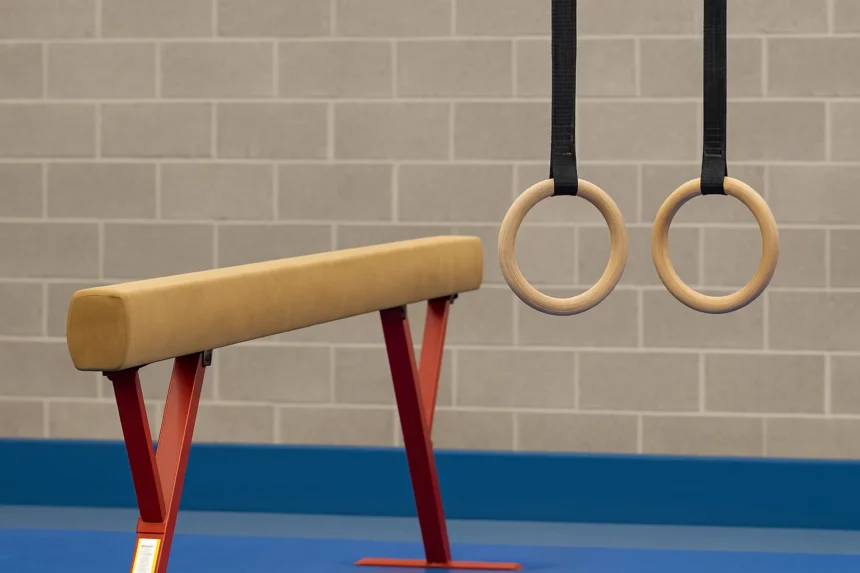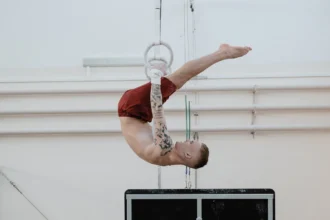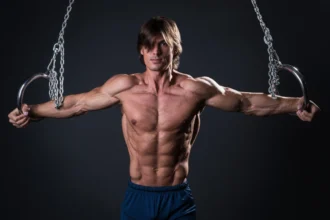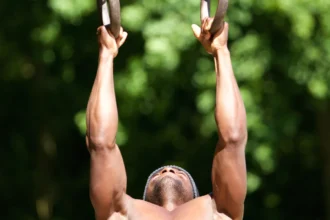In artistic gymnastics, men and women compete on different sets of events. Men have six apparatuses, including the still rings, but never perform on the balance beam. Women compete on four events, including beam, but never touch the rings.
So why the divide? Is it because of physical ability? Safety concerns? Or something deeper?
Beam: Inspired by Ballet and Early Women’s PE
The balance beam was designed specifically for women. It was influenced by 19th-century European physical education programs that focused on posture, balance, and graceful movement.
Early beam routines looked more like ballet than gymnastics, full of walking, poses, and arm movements instead of flips or acrobatic tricks.
When women began competing in Olympic gymnastics in the 1920s and 1930s, the beam became a way to show off qualities that were seen as “feminine” at the time: grace, control, and elegance.
By the 1952 Olympics, the women’s event list, vault, uneven bars, beam, and floor, was officially set.
Rings: Built for Strength and Power
The still rings have a very different background. They came from military-style men’s training in the 1800s, especially in German gymnastics clubs called Turnvereins.
Rings were used to show raw upper-body strength with skills like the Iron Cross, planche, and inverted cross—moves that require incredible control and muscle.
From the start, rings were only part of men’s gymnastics. Meanwhile, women’s events were built around flexibility, rhythm, and dance-like movement.
So from early on, the split between beam and rings reflected traditional views: strength for men, grace for women.
Why Men Don’t Compete on Beam
There’s no rule that says men can’t do beam—but there are a few practical reasons why they usually don’t:
- Balance Challenges: Men tend to have a higher center of gravity than women, which can make balancing on a 10-centimeter-wide beam harder.
- Flexibility Requirements: Beam routines include leaps, splits, and body lines that require a high level of flexibility, something women often develop more naturally.
- Training Focus: Men’s gymnastics focuses more on upper-body strength through events like rings, pommel horse, and parallel bars. Beam, by contrast, relies more on lower-body balance and control.
Also, men already perform on the pommel horse, which tests balance and coordination, but in a very different way.
Why Women Don’t Compete on Rings
Just like men aren’t blocked from beam, women aren’t banned from rings. But rings require a special kind of strength that’s much harder for most women to build:
- Upper-Body Muscle Mass: Women generally have more strength in their lower bodies, while the rings demand extreme upper-body control.
- High Injury Risk: Moves like the Maltese and Iron Cross put a lot of pressure on the shoulders and joints. Without the right strength buildup, these can lead to injuries.
In short, the rings are built for the type of training and muscle development more common in male gymnasts. Meanwhile, women’s apparatuses highlight skills like dynamic movement, grace, and control.
Voices from the Field: Reddit & Expert Perspectives
Gymnasts and fans have long discussed these event divisions. On forums like Reddit’s r/Gymnastics and r/Olympics, users offer some helpful context:
“Way back when, beam routines were basically dance exercises… It probably would not have been considered a masculine event, and thus was left to the ladies.”
— DanielEng, r/Gymnastics
This lines up with what we know from history: early beam was all about posture and grace, which didn’t match traditional ideas of “masculine” sports.
Another Redditor points out how body type played a role in assigning events:
“Men do p‑bars and women uneven bars because of body type. The broadest part of a man’s body is his shoulders whereas the broadest part of a woman’s body is her hips, meaning it’s hard for women to do p‑bars.”
— User on r/Gymnastics
These insights show that while body mechanics matter, many of the reasons for separating events came from old-fashioned gender roles, not actual limitations.
So… Could That Ever Change?
Some coaches and athletes are open to experimenting. Male gymnasts sometimes use the beam during training to improve balance. And women in CrossFit or calisthenics sometimes try rings for upper-body workouts.
However, official competitions like the Olympics aren’t likely to change anytime soon. The current event structure is deeply built into the rules and scoring systems of gymnastics.
Still, conversations about inclusion and evolution are growing. In programs like NAIGC (National Association of Intercollegiate Gymnastics Clubs), athletes of any gender can train on any event.
While change is possible, for now, the apparatus divide remains one of the most visible differences between men’s and women’s gymnastics.






